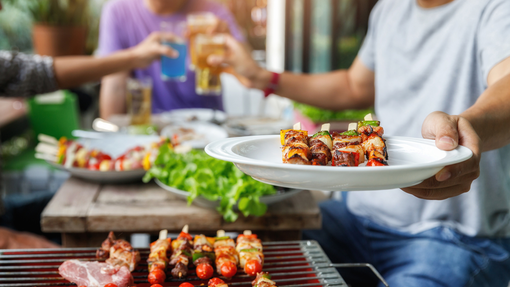
How do I write shopping lists that work for me?
Why should I try this?
Many of us often pop into the shop uncertain if we already have enough food like milk, bread and potatoes so we end up guessing and buy it ‘just in case’. A shopping day can quickly turn into bin day as our perfectly edible old food gets thrown away to make space for the new.
A shopping list is an easy way to help you buy only what you need from your food shop which not only helps protect our planet it also helps you stick to your budget too.
By following a few simple steps to create a shopping list that works for you, you’ll be able to save time in the shop and avoid doubling up on food you already have at home. Try some of our tried and tested top tips and hacks and find how you can ensure it takes minimal time to complete each week.
The average UK family could save £83 per month, around £1,000 per year, by saving food from the bin.
How do I do this?
Step one
Find a method of writing a list that works for you
We are all different, so here are a few options to try to find one that is best for you:
-
Use your mobile phone
-
Use a wipe board on your fridge
-
Use pen and paper
-
Quick list - no time to write a full list
Go to your ‘notes’ app and create a note called ‘Shopping list’. You can then write a list of your go-to foods and just delete what you already have when you check what food still needs eating at home and just add new items, when required. To save time, you could copy and paste your go-to list of foods at the top of your note so you don’t have to re-write it every time you create a new list.
Put a magnetic wipe board on your fridge and keep it up to date as you run out of food and when you create your meal plan. Then simply take a photo of your board to go shopping.
If you prefer to write out your list so that you can tick it off in the shop then simply use a note pad and pen. It means you’ll need to write it out every time, however, if it works best for you in the shop then this is the best one for you. Although you might like to try adding your list to your phone and just deleting items when you’ve put the in your trolley.
Sometimes life runs a way with us and time pressures increase. If you simply don’t have time to write a list then simply take a ‘shelfie’ of your fridge and cupboard to remind you what food you already have at home.
A few additional top tips
- Keep a list of the most common foods that you buy each week to hand – then just copy and paste into a new note if using your phone and delete what you don’t need when checking your cupboards, fridge and freezer. If using a wipe board or paper list – use this list to remind you what you might need. It’ll save time writing it out all the time and helps you easily remember your go-to foods.
- Keep your list up to date throughout the week then sense check it just before you go to the shop – saves you having to write a list in the moments before you hit the shop when you are likely to have the least amount of time.
- Try to organise your list around the shop layout – base your list on how the shop is laid out, group the same types of foods e.g. bakery, pick your frozen food last (it will stay cooler for longer while you get it home).
- Add food to your list throughout the week, when you run out of something – It only takes a second.
- Remember to add your non-food items too e.g. shampoo, toothpaste, loo rolls, etc.
Step two
Step two
What meals are you going to make this week?
Meal plans
- Having a meal plan to hand will save you time when creating your shopping list, particularly if you start writing your shopping at the time you create your meal plan.
- Using a meal plan to write your shopping list will take the guesswork out of calculating how much food you’ll actually eat during the week.
- Meal plans help you rationalise your shopping list too – if recipes need similar foods e.g. root vegetables for curry, stews, soups, then you can swap out food mentioned in the recipe for something similar and use up whole packs rather than buying different types of food and only using half the pack e.g. swap parsnips for carrots. The great alternative is to buy your fruit and vegetables loose.
Who’s in, who’s out? - Check your calendar to see who’s in and who’s out for mealtimes.
What’s your food budget? - Make a note of this and plan your meals around your budget.
Step three
Step three
Check what food do you already have at home
- Fresh food isn’t the only way to buy food – think about what food you can buy to put in your cupboard and freezer. This food will last longer, particularly when your plans may change last minute.
- Remember to look at what’s at the back of the fridge and cupboards too – it’s easy for food to get forgotten when new food is put away.
- Move food that needs eating up right now to the front of the shelf or create an ‘eat me first’ shelf. Check out our Weekly food routine tool for some other quick food habits to adopt each week that’ll save you time and money.
- Forgotten food - If you have food you thought you’d use but just haven’t had the time to use – now is the time to do something about it. Freeze it (tips are available in our food pages), make a meal and freeze for later, or give to someone who will be able to use it e.g. aps like Olio
- Staple foods - It’s worth keeping some food at home that helps you use up leftovers so keep an eye on what you have in your cupboard e.g. canned tomatoes, rice and dried pasta.
Step four and finally
Step four
Sense check your list just before you go shopping or order online
- Have a quick glance in your fridge, cupboards and freezer – what still needs eating vs what’s on your list?
- Have plans changed next week re: who’s in/out and has anything changed that will impact the time you have available to cook/prepare planned meals?
- Remember to check any coupons you have and take them with you e.g. supermarket loyalty cards etc
And finally, when you are in the shop
- Shop and scan - If you can, use a shop and scan handheld device – it saves time packing as you pack as you go, and it adds up your shopping as you go too, helping you stick to your budget.
- Remember to tick/delete your items off your list when it’s in your trolley.
- Special offers – pause for a moment and think – ask yourself when will you eat the food?, do you really need twice the amount? … so will it actually save you money? Consider trying own brand food – quite often it’s as good and nutritious as branded food and costs less too.
- Remember to use your coupons – every penny saved counts.
- Distract your little folk by giving them an easy game to play while in the shop e.g. count how many food items you see that have green packaging, pre-draw a basket on paper at home and ask them to draw food to put in their basket or ask them to help you find the food on the shelves (if they can).
- Super end-of-day deals – if you shop at the end of the day then you might find some brilliant deals when food is marked down for sale. Sense check if it’s something you can use though – a great deal on food is only one that you’ll end up eating and not throwing away. You can freeze food up to its Use by date, if it has one.
What you may begin to notice
Once you’ve found a method that works for you and you keep doing it each week, it’ll start to become a natural part of your weekly routine and need less energy thinking about it. You’ll also start to find other small things that make writing shopping lists easier for you – please share your top tips with us in our social media communities (links are in the footer).
Over time, shopping will be become quicker and easier, you’ll become a real expert at sticking to your food budget and you should notice that you start spending a bit less on food as you are only buying what you can eat. You’ll also notice that less food is going in the bin as you’ll have reduced the moments where you bought food you already had at home.




